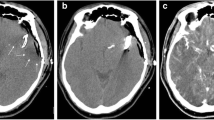Abstract
The purpose of this study was to assess virtual unenhanced brain computed tomography (CT) images obtained by dual-energy CT angiography (CTA) for the detection of intracranial bleeding. In total, 25 patients were included in the study (average age 53.2 years, range 25–75 years, 14 male, 11 female), all with intracranial bleeding on unenhanced brain CT and who underwent additional CTA performed on a dual-source CT in a dual-energy acquisition mode. The two X-ray tubes were operated at 140 and 80 kV, respectively. Data were analyzed using dual-energy evaluation software. Virtual unenhanced images were calculated by removing the relative iodine content from each voxel. The virtual unenhanced images were evaluated by a radiologist blinded to the findings of the conventional images related to the presence of intracranial bleeding. The image quality and contrast-to-noise ratio (CNR) between bleeding and brain tissue were assessed. The virtual image quality was found to be sufficient in 96%. The agreement in detection of intracranial bleeding on virtual and conventional unenhanced images reached 96% in per-lesion analysis and 100% in per-patient analysis. The averaged CNR reached 2.63 in virtual unenhanced images and 3.27 in conventional. Virtual unenhanced images are sufficient for the detection of intracranial bleeding.



Similar content being viewed by others
References
Biller J, Godersky JC, Adams HP Jr (1988) Management of aneurysmal subarachnoid hemorrhage. Stroke 19:1300–1305
Westerlaan HE, Gravendeel J, Fiore D et al (2007) Multislice CT angiography in the selection of patients with ruptured intracranial aneurysms suitable for clipping or coiling. Neuroradiology 49:997–1007
Agid R, Lee SK, Willinsky RA, Fard RI, Brugge KG (2006) Acute subarachnoi hemorrhage: using 64-slice multidetector CT angiography to “triage” patients’ treatment. Neuroradiology 48:787–794
Johnson TR, Krauss B, Sedlmair M et al (2007) Material differentiation by dual energy CT: initial experience. Eur Radiol 17:1510–1517
Ferda J, Flohr T, Kreuzberg B (2008) Tissue imaging with dual-energy computed tomography – initial clinical experience. Ces Radiol 62:11–22
Thieme SF, Becker CR, Hacker M et al (2008) Dual energy CT for the assessment of lung perfusion – correlation to scintigraphy. Eur J Radiol 68(3):369–374
Ferda J, Baxa J, Mírka H et al (2008) “Ventilation-perfusion” imaging of the lung using dual-energy CT. Ces Radiol 62:277–284
Stolzmann P, Frauenfelder T, Pfammatter T et al (2008) Endoleaks after endovascular abdominal aortic aneurysm repair: detection with dual-energy dual-source CT. Radiology 249:682–691
Chae EJ, Song J-W, Seo JB, Krauss B, Jang YM, Song K-S (2008) Clinical utility of dual-energy CT in the evaluation of solitary pulmonary nodules: initial experience. Radiology 249:671–681
Schwartz RB, Tice HM, Hooten SM, Hsu L, Stieg PE (1994) Evaluation of cerebral aneurysms with helical CT: correlation with conventional angiography and MR angiography. Radiology 192(3):717–722
Acknowledgements
This study was supported by the Czech MSM research project no. 0021620819.
Author information
Authors and Affiliations
Corresponding author
Rights and permissions
About this article
Cite this article
Ferda, J., Novák, M., Mírka, H. et al. The assessment of intracranial bleeding with virtual unenhanced imaging by means of dual-energy CT angiography. Eur Radiol 19, 2518–2522 (2009). https://doi.org/10.1007/s00330-009-1495-2
Received:
Revised:
Accepted:
Published:
Issue Date:
DOI: https://doi.org/10.1007/s00330-009-1495-2




